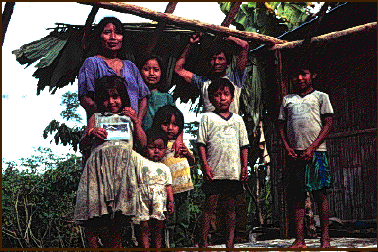 to
Ecotourism Research Home Page
to
Ecotourism Research Home Page
The Case of Río Blanco, Ecuador |
 Scholars often seem to operate on the assumption that any analysis with a rosy outlook simply does not adequately understand the matter at hand. Ecotourism researchers have not been derelict in this regard, as the literature review earlier showed. All the researchers who have looked at Capirona's project, however, have been impressed by its grassroots nature and are optimistic about its potential as eco-development (Colvin 1994, Wesche 1993, Silver 1992).
All of these researchers, however, visited the community in its early years of operation. As mentioned previously, recent, non-scholarly reports are less positive. Thus there remains some doubt as to the long-term viability of even such a model of indigenous ecotourism development as Capirona. This study originally proposed to study Capirona's project, but that community was weary of such research visits and refused a request to carry out the study there. Río Blanco, though completing only its first year of ecotourism development, was chosen as an alternate site. Perhaps it should not be surprising that the prospects for ecotourism in Río Blanco appear, as they did in Capirona, quite bright.
Ecotourism as Development, Part One
Scholars often seem to operate on the assumption that any analysis with a rosy outlook simply does not adequately understand the matter at hand. Ecotourism researchers have not been derelict in this regard, as the literature review earlier showed. All the researchers who have looked at Capirona's project, however, have been impressed by its grassroots nature and are optimistic about its potential as eco-development (Colvin 1994, Wesche 1993, Silver 1992).
All of these researchers, however, visited the community in its early years of operation. As mentioned previously, recent, non-scholarly reports are less positive. Thus there remains some doubt as to the long-term viability of even such a model of indigenous ecotourism development as Capirona. This study originally proposed to study Capirona's project, but that community was weary of such research visits and refused a request to carry out the study there. Río Blanco, though completing only its first year of ecotourism development, was chosen as an alternate site. Perhaps it should not be surprising that the prospects for ecotourism in Río Blanco appear, as they did in Capirona, quite bright.
Ecotourism as Development, Part One| Improve/advance our lives | 4 |
| Protect land/forest | 3 |
| Earn money | 3 |
| Replace agricultural income | 1 |
| Develop community | 1 |
| Revive culture | 1 |
| Cash Crops | Tourism Project | Tourist Crafts | Other* | Total | |
|---|---|---|---|---|---|
| 1995 Actual | $400 (73%) | $100 (18%) | $20 (4%) | $27 (5%) | $547 |
| 1996 Potential | $400 (60%) | $200 (30%) | $40 (6%) | $27 (4%) | $667 |
| Quichua language or bilingualism | 10 | The forest/To live in the forest | 12 |
| To live on Quichua land | 2 |
| Arts/Culture | 2 |
 to
Ecotourism Research Home Page
to
Ecotourism Research Home Page
 to
Río Blanco Summary Page
to
Río Blanco Summary Page
 to
Río Blanco Appendix
to
Río Blanco Appendix